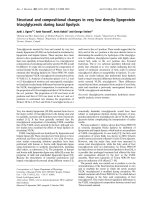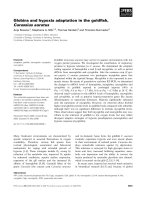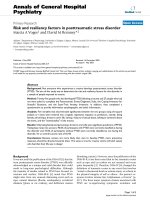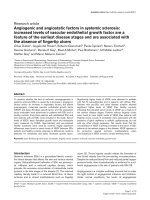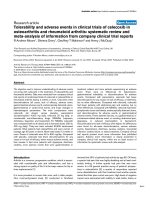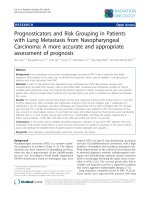Báo cáo y học: "Bacterial and fungal microflora in surgically removed lung cancer samples." potx
Bạn đang xem bản rút gọn của tài liệu. Xem và tải ngay bản đầy đủ của tài liệu tại đây (485.95 KB, 5 trang )
RESEARCH ARTICLE Open Access
Bacterial and fungal microflora in surgically
removed lung cancer samples
Panagiotis Apostolou
1
, Aggeliki Tsantsaridou
2
, Ioannis Papasotiriou
1
, Maria Toloudi
1
, Marina Chatziioannou
1
and
Gregory Giamouzis
3*
Abstract
Background: Clinical and experimental data suggest an association between the presence of bacterial and/or
fungal infection and the development of different types of cancer, independently of chemotherapy-induced
leukopenia. This has also been postulated for the development of lung cancer, however the prevalence and the
exact species of the bacteria and fungi implicated, have not yet been described.
Aim: To determine the presence of bacteri al and fungal microflora in surgically extracted samples of patients with
lung cancer.
Materials and methods: In this single-center prospective, observational study, tissue samples were surgically
extracted from 32 consecutive patients with lung cancer, and reverse-transcription polymerase chain reaction (RT-
PCR) was used to identify the presence of bacteria and fungi strains.
Results: The analysis of the electrophoresis data pointed out diversity between the samples and the strains that
were identified. Mycoplasma strains were identified in all samples. Strains that appeared more often were
Staphylococcus epidermidis, Streptococcus mitis and Bacillus strains, followed in descending frequency by
Chlamydia, Candida, Listeria, and Haemophilus influenza. In individual patients Legionella pneumophila and
Candida tropicalis were detected.
Conclusions: A diversity of pathogens could be identified in surgically extracted tissue samples of patients with
lung cancer, with mycoplasma strains being present in all samples. These results point to an etiologic role for
chronic infection in lung carcinogenesis. Confirmation of these observations and additional studies are needed to
further characterize the etiologic role of inflammation in lung carcinogenesis.
Keywords: lung cancer, bacteria, fungi, reverse-transcription polymerase chain reaction
Introduction
Lung cancer is the most common cancer worldwide,
with 1.35 million incident c ases annually, and consists
one of the leading causes of mortality worldwide [1]. In
addition to cigarette smoking, the major lung cancer
risk factor [1], recent studies underscore a n etiologic
role for chronic pulmonary infection in lung carcinogen-
esis, acting either independently or as a cofactor to
tobacco smoke in increasing lung cancer risk [2-5].
Experimental and clinical data correlate cancer develop-
ment with the presence of certain pathogens, indepen-
dently of chemotherapy-induced leucopenia [6-8].
Indeed, mycoplasma is one o f the most often observed
pathogen in lung carcinomas [9], and it has been postu-
lated that mycoplasma-infected cells have a higher abil-
ity to metastasize in vivo than non-mycoplasma-infected
cells [10] . Very similarly, the bacterium Chlamydia
pneumoniae, a common cause of community-acquired
pneumonia, has been implicated in lung carcinogenesis
[11-16]. Staphylococcus strains likewise have been
observed in many cases of pa tients with lung cancer
[6,7,17-19]. Other studies have demonst rated the pre-
sence of colonies in respiratory tract in patients with
cancer [19]; Haemophilus influenza [6,7,19-21] and Can-
dida albicans [7,20-22] have been found in patients with
lower respiratory tract malignancies. Legionella pneymo-
phila has been diagnosed in patients with cancer [23], as
* Correspondence:
3
Cardiology Department, Larissa University Hospital, Larissa, Greece
Full list of author information is available at the end of the article
Apostolou et al. Journal of Cardiothoracic Surgery 2011, 6:137
/>© 2011 Apostolou et al; licensee BioMed Central Ltd. This is an Open Access article distributed under the terms of the Cre ative
Commons Attribution License ( which permits unrestricted use, distribution, and
reproduction in any medium, provided the original work is properly cited.
well as strains of Bacillus [7], Listeria [24], and S trepto-
coccus [6,7,17,19,25].
Importantly, previous retrospective and prospective stu-
dies have relied on serologic characterization of chronic
bacterial and fungal infections [14]. To the best of our
knowledge, the prevalence of bacterial and/or fungal infec-
tion in surgically extracted samples of patients with lung
cancer has not been previously reported. The aim of the
present study, therefore, was to determine the presence of
bacterial and fungal microflora in surgically removed tis-
sue samples of patients with lung cancer, by using PCR
methods and special primers.
Materials and methods
In this single-center prospective, observational study, tis-
sue samples were surgically removed from 32 consecutive
patients with lung cancer. The samples were maintained
in RPMI culture medium (Sigma, R0883, Germany). The
tissue was dissociated and 2 ml Trypsin - 0,25% EDTA
(Invitrogen, 25200-072, California ) was added in order to
detach the cells. The trypsin has been inactivated by
using FBS (Invitrogen, 10106-169, California) and cells
were centrifuged at 1,200 rpm for 10 min. Then cells
were incubated in 25 cm
2
flasks (Orange Scientific,
5520200, Belgium) at 37°C, in a 5% CO2 atmosphere,
until well developed. RNA wa s extracted using TRIZOL
(Invitrogen, 15596-026, California) and was used as a
template to generate cDNA using the First strand cDNA
synthesis kit (Fermentas, K1612, Canada). The First
strand cDNA was used as a template for the Gradient-
PCR reaction, which was performed using GoTaq Flexi
polymerase (Promega, M8305, USA). Primers have been
designed with Gene Expression 1.1 software. The PCR
conditions we re set as follows: initial den aturation at
95°C for 10 min to activate the polymerase, 35 cycles of
denaturation at 94°C for 45 s ec, followed by annealing at
52-58°C for 45 sec and an extension step at 72°C for
60 sec. A final extension step was performed at 72°C f or
10 min. The PCR products were then separated on 1.5%
agarose gel (Merck, 1012 360500, USA) stained with Gel-
Green (Gentaur, 41005, Belgium), and finally observed
under UV-light. A 100-bp ladder (Promega, G2101, USA)
was used as marker.
This study was in compliance with the Helsinki Declara-
tion. All participants gave informed consent and the study
was approved by the institutional board review.
Results
Table 1 shows the primer pairs that were used in PCR to
identify the specific pathogen strains. Table 2 presents the
frequency of different species and strains in the samples
that were examined. The analysis of the electrophoresis
data pointed out diversity between the samples and the
strains that were identified in them. Mycoplasma strains
Table 1 Primer pairs that have been used in PCR
Organism Species Forward Primer (5’-3’) Reverse Primer (5’-3’) PCR Product (bp)
Treponema pallidum AATGCGGTGGCGTAGCGATAC TTTTGCGGTTTGCTCCACTTC 275
denticola AGGGATATGGCAGCGTAGCAATA CGTCCTCCCTTACGGGTTAGACT 453
vincentii GCGGTATGTAAGCCTGGTGTGAA TTTGCTTTGGCACTGAAGCTCTT 277
Neisseria meningitidis AAGTCGGACGGCAGCACAGA TCAGCCGCTGATATTAGCAACAG 421
Legionella pneumophila AAGATTAGCCTGCGTCCGATTAG AACCCTCCTCCCCACTGAAAGT 232
Borrelia burgdorferi CATGCAAGTCAAACGGGATGTA GACCTTCTTCATTCACGCAGTG 361
americana
valaisiana
garinii
recurrentis
hispanica
duttonii
lusitaniae
spielmanii
Listeria grayi TCTTGACATCCTTTGACCACTCTG TGCACCGGCAGTCACTTTAGAG 157
innocua
monocytogenes
welshimeri
Helicobacter pylori GATTGGCTCCACTTCGCAGTA GGCGACCTGCTGGAACATT 560
pullorum
equorum
canadensis
Apostolou et al. Journal of Cardiothoracic Surgery 2011, 6:137
/>Page 2 of 5
were identified in all samples (Figure 1 demonstrates elec-
trophoresis results f or Mycoplasma strains). Strains that
appeared more often were Staphylococcus epidermidis,
Streptococcus mitis and Bacillus strains , followed in des-
cending frequency by Chlamydia, Candida, Listeria, and
Haemophilus influenza. In individual patients Legionella
pneumophila and Candida tropicalis were detected.
Discussion
Lung cancer is the most common cancer worldwide and is
a leading causes of mortali ty worldwid e [1]. Many recent
studies have underscored the etiologic role of chronic pul-
monary infection in lung carcinogenesis, concluding that
inflammation increases the risk for incident lung cancer
[2-5]. Numerous studies on lung cancer have pointed out
the appearance of Mycoplasma strains in patients and sug-
gest association of infection with tumorigenesis; it has
been postulated that mycoplasma-infected cells have a
higher ability to metastasize in vivo than non-myco-
plasma-infected cells [10]. Candida species have been iso-
lated from patients with lower respiratory tract infection
[7,20-22]. Haemophilus influenza [6,7,19-21], Staphylococ-
cus epidermidis [6,7,17-19], Streptococcus species
[6,7,17,19,25], Legionella pneymophi la [23], as well as
strains of Bacillus [7], Listeria [24] and Streptococcus
[6,7,17,19,25] have been also identified in patients with dif-
ferent pulmonary diseases. Very similarly, the bacterium
Chlamydia pneumoniae, a common cause of community-
acquired pneumonia, has been implicated in lung carcino-
genesis [11-16]. A recent meta-analysis by Zhan et al. [16]
Table 1 Primer pairs that have been used in PCR (Continued)
Staphylococcus aureus AGGCGACTTTCTGGTCTGTAACTG CCGAAGGGGAAGGCTCTATCT 307
Haemophilus parasuis CCTTGGGAAAATACTGACGCTCAT TCCCGAAGGCACACTCTCAT 297
Chlamydia muridarum TGTTTAGTGGCGGAAGGGTTAG CCGTCCATTGCGAAAGATTC 304
trachomatis
Bacillus pumilus TGCAAGTCGAGCGGACAGA TCCCAGTCTTACAGGCAGGTTAC 91
aerophilus
licheniformis
amyloliquefaciens
subtilis
Bacillus II anthracis CGGCTTCGGCTGTCACTTATG TCAGCACTAAAGGGCGGAAAC 655
cereus
thuringiensis
Mycoplasma pneumoniae GAGGCGAACGGGTGAGTAACA CGCGACTGCTGGCACATAGT 441
pirum
gallicepticum
genitalium
amphoriforme
Leptospira borgpetersenii GGATAGCCCCGAGAGGTCATA CCATCATCACATCGCTGCTTAT 299
Leptospira meyeri CGAATGTGACGGTTCCTGGTAG TTCGCCCATTGAGCAAGATT 210
biflexa
Staphylococcus epidermidis GTGAAAGACGGTTTTGCTGTCAC CGGATAACGCTTGCCACCTAC 359
Streptococcus mitis GGAGCTTGCTCTTCTGGATGAG GAGCCGTTACCCCACCAACT 197
Leptospira interrogans CAGCCTGCACTTGAAACTATGTG ATAGTCCCCAGGCGGTCTACT 266
Brachyspira hyodysenteriae TGCCGTAGAGTGGGGGATAA CCGCAGGCTCATCGTAAAG 109
aalborgi
intemedia
alvinipulli
innocens
suanatina
Haemophilus influenzae CTTGCTTTCTTGCTGACGAGTG TCTCAGTCCCGCACTTTCATC 129
Candida I albicans CCAGCCGAGCCTTTCCTTCT TACCCCCGACCGTCCCTATT 187
parapsilosis
dubliensis
Candida tropicalis CGGTCGGGGGTATCAGTATTC ATACTCGCTGGCTCCGTCAGT 622
Apostolou et al. Journal of Cardiothoracic Surgery 2011, 6:137
/>Page 3 of 5
of 12 studies involving 2595 lung cance r cases and 2585
controls from four prospective studies and eight retrospec-
tive studies, was conducted to analyze the association
between C. pneumoniae infection and risk of lung cancer.
Overall, people exposed to C. pneumoniae infection had
an odds ratio (OR) of 1.48 (95% confidence interval (CI),
1.32-1.67) for lung cancer risk, relative to those not
exposed. Of interest, a higher titre was an even better risk
prognosticator (OR for IgA ≥64 cutoff group, 2.35; 95%
CI, 1.88-2.93; OR for IgA ≥16 cutoff group, 1.22; 95% CI,
1.06-1.41).
These data s trongly support the idea that l ung cancer i s a
biofilm associated chronic infection. Biofilms are microor-
ganism populations organized in a form of colonies using
self-produced extracellular matrix that works as infrastruc-
ture material. The vast majority of the micro-“colonists”
establish biofilms on any inert or diseased biological sur-
face. They adhere to each other, divide, cooperate, and,
progressively, their bio-mass grows, matures and finally
disperses. It resembles malignant beha vior (tumors com-
posed by cancer cells and by stroma cells-monocytes, lym-
phocytes, microvessels, can metastasize). Therefore, many
researchers imply that lung malignancies are communities
of diverse pathogens resistant to antibiotics.
One of the major limitations in most of the previous
studies was the use of serologic characterization to iden-
tify chronic bacterial or fungal infections [14]. This has
resulted in conflicting results and great variability in
relative risk estimations among seropositive individuals
[14,15,26-29]. This wide variability could al so reflect the
retrospective nature of most of the studies, the small
sample sizes, or inadequate adjustm ent for confounding
factors [14]. New techniques, such as PCR-RFLPs,
Matrix-assisted laser desorption ionization time-of-flight
mass spectrometry (MALDI-TOF MS) a nd microcolony
methods allow examination and analysis of microbial
communities [30,31]. Analyzing the constituents of
microbial biofilms responsible for lung disease may help
us discover novel strategies to control malignancies.
To the best of our knowledge, the prevalence of bacterial
and/or fungal infection in surgically extracted samples
of patients with lung cancer has not been previously
reported. Therefore, the main purpose of the present
study was to determine the presence of bacterial and fun-
gal microflora in surgically removed tissue samples of
patients with lung cancer, by using PCR methods and spe-
cial primers. In this study, specific primers were designed
in order to amplify as many different strains of microor-
ganisms. Pairs of primers that were designed were capable
of amplifying Treponema, Neisseria, Legione lla, Borre lia,
Listeria, Helicobacter, Staphylococcys, Haemophilus, Bacil-
lus, Leptospira, Streptococcus, Mycoplasma, Candida and
Brachyspira species. I t is worth noting that Mycoplasma
species were observed in all samples. Staphylococcus epi-
dermidis and Streptococcus mitis were almost seen in one
quarter of patients. Neither Treponema strains nor
Leptospira, Helicobacter, and Staphylococcus aureus
strains were observed in this study.
Conclusion
A diversity of pathogens could be identified in surgically
extracted tissue samples of patients with lung cancer,
with mycoplasma strains being present in all samples.
These results point to an etiologic role for chronic
infection in lung carcinogenesis. Confirmation of these
Table 2 Prevalence by different species and strains
Pathogen Strain Prevalence (%)
Legionella pneumophila 3.125
Listeria grayi 9.375
innocua
monocytogenes
welshimeri
Chlamydia muridarum 12.5
trachomatis
Bacillus pumilus 28.125
aerophilus
licheniformis
amyloliquefaciens
subtilis
Staphylococcus epidermidis 25
Streptococcus mitis 21.875
Haemophilus influenzae 6.25
Mycoplasma pneumonia 100
pirum
gallicepticum
genitalium
amphoriforme
Candida albicans 12.5
parapsilosis
dubliensis
Candida tropicalis 3.125
Figure 1 Electrophoresis results for Mycoplasma strains.
Apostolou et al. Journal of Cardiothoracic Surgery 2011, 6:137
/>Page 4 of 5
observations and additional studies are needed to
further characterize the etiologic role of inflammation in
lung carcinogenesis, thus making it possible to apply
new therapeutic modalities.
Author details
1
Research Genetic Cancer Centre Ltd (R.G.C.C. Ltd), Filotas, Florina, Greece.
2
Department of Cardiovascular and Thoracic Surgery, Larissa University
Hospital, Larissa, Greece.
3
Cardiology Department, Larissa University Hospital,
Larissa, Greece.
Authors’ contributions
PA carried out the molecular studies and drafted the manuscript. AT
participated in the design of the study and collected all tissue samples. IP
participated in the design of the study and coordination. MT carried out the
molecular studies and drafted the manuscript. MC carried out the molecular
studies and drafted the manuscript. GG performed the statistical analysis and
drafted the manuscript.
All authors read and approved the final manuscript.
Competing interests
The authors declare that they have no competing interests.
Received: 8 August 2011 Accepted: 14 October 2011
Published: 14 October 2011
References
1. Alberg AJ, Brock MV, Samet JM: Epidemiology of lung cancer: looking to
the future. J Clin Oncol 2005, 23(14):3175-85.
2. Sun S, Schiller JH, Gazdar AF: Lung cancer in never smokers–a different
disease. Nat Rev Cancer 2007, 7(10):778-90.
3. Govindan R: Lung cancer in never smokers: a new hot area of research.
Lancet Oncol 11(4):304-5.
4. Engels EA: Inflammation in the development of lung cancer:
epidemiological evidence. Expert Rev Anticancer Ther 2008, 8(4):605-15.
5. Ballaz S, Mulshine JL: The potential contributions of chronic inflammation
to lung carcinogenesis. Clin Lung Cancer 2003, 5(1):46-62.
6. Dancewicz M, et al: [Bronchial bacterial colonization in patients with lung
cancer]. Pneumonol Alergol Pol 2009, 77(3):242-7.
7. Szymankiewicz M, Kowalewski J, Dancewicz M: [Bacteriological and
mycological analysis of material taken from lower respiratory tract in
patients with malignancy]. Pol Merkur Lekarski 2006, 21(123):218-22.
8. Pieper R, Book K, Nord CE: Microbial flora associated with pulmonary
neoplasms. Scand J Thorac Cardiovasc Surg 1984, 18(3):259-61.
9. Huang S, et al: Mycoplasma infections and different human carcinomas.
World J Gastroenterol 2001, 7(2):266-9.
10. Ushio S, et al: Metastasis-promoting activity of a novel molecule, Ag 243-
5, derived from mycoplasma, and the complete nucleotide sequence.
Microbiol Immunol 1995, 39(6):393-400.
11. Chaturvedi AK, et al: Chlamydia pneumoniae infection and risk for lung
cancer. Cancer Epidemiol Biomarkers Prev 2010, 19(6):1498-505.
12. Anttila T, et al: Chlamydia pneumoniae infection and the risk of female
early-onset lung cancer. Int J Cancer 2003, 107(4):681-2.
13. Koyi H, et al: Chlamydia pneumoniae may be associated with lung
cancer. Preliminary report on a seroepidemiological study. APMIS 1999,
107(9):828-32.
14. Littman AJ, Jackson LA, Vaughan TL: Chlamydia pneumoniae and lung
cancer: epidemiologic evidence. Cancer Epidemiol Biomarkers Prev 2005,
14(4):773-8.
15. Littman AJ, et al: Chlamydia pneumoniae infection and risk of lung
cancer. Cancer Epidemiol Biomarkers Prev 2004, 13(10):1624-30.
16. Zhan P, et al: Chlamydia pneumoniae infection and lung cancer risk: a
meta-analysis. Eur J Cancer 2011, 47(5):742-7.
17. Balasaniants GS, Torkatiuk EA: [Microbial spectrum of respiratory tract in
patients with different pulmonary diseases]. Zh Mikrobiol Epidemiol
Immunobiol 2010, , 6: 7-11.
18. Korona-Glowniak I, et al: [Phenotypic characteristics of coagulase-negative
Staphylococci colonizing pleural drains in patients with lung cancer
after thoracic surgery]. Med Dosw Mikrobiol 2003, 55(2):109-15.
19. Rancic M, Ristic L, Stankovic I: [Infective complications in patients with
lung cancer]. Med Pregl 2011, 63(9-10):643-7.
20. Jha BJ, et al: Characterization of Candida species isolated from cases of
lower respiratory tract infection. Kathmandu Univ Med J (KUMJ) 2006,
4(3):290-4.
21. Laroumagne S, et al: [Incidence and characteristics of bronchial
colonisation in patient with lung cancer: a retrospective study of 388
cases]. Rev Mal Respir 2011, 28(3):328-35.
22. Dendis M, et al: PCR-RFLP detection and species identification of fungal
pathogens in patients with febrile neutropenia. Clin Microbiol Infect 2003,
9(12):1191-202.
23. Nunnink JC, Gallagher JG, Yates JW: Legionnaires’ disease in patients with
cancer. Med Pediatr Oncol 1986, 14(2):81-5.
24. Khardori N, et al: Spectrum and outcome of microbiologically
documented listeria monocytogenes infections in cancer patients.
Cancer 1989, 64(9):1968-70.
25. Jassem E, et al: [Non-sporeforming anaerobic bacteria in bronchoalveolar
lavage fluid of patients with pneumonia during the course of lung
cancer]. Pneumonol Alergol Pol
1997, 65(9-10):643-8.
26. Laurila AL, et al: Serological evidence of an association between
Chlamydia pneumoniae infection and lung cancer. Int J Cancer 1997,
74(1):31-4.
27. Jackson LA, et al: Association of Chlamydia pneumoniae immunoglobulin
A seropositivity and risk of lung cancer. Cancer Epidemiol Biomarkers Prev
2000, 9(11):1263-6.
28. Smith JS, et al: Lack of association between serum antibodies of
Chlamydia pneumoniae infection and the risk of lung cancer. Int J
Cancer 2008, 123(10):2469-71.
29. Koh WP, et al: Lack of association between chronic Chlamydophila
pneumoniae infection and lung cancer among nonsmoking Chinese
women in Singapore. Int J Cancer 2005, 114(3):502-4.
30. Girjes AA, Carrick FN, Lavin MF: Single DNA sequence common to all
chlamydial species employed for PCR detection of these organisms. Res
Microbiol 1999, 150(7):483-9.
31. Hsieh SY, et al: Highly efficient classification and identification of human
pathogenic bacteria by MALDI-TOF MS. Mol Cell Proteomics 2008,
7(2):448-56.
doi:10.1186/1749-8090-6-137
Cite this article as: Apostolou et al.: Bacterial and fungal microflora in
surgically removed lung cancer samples. Journal of Cardiothoracic Surgery
2011 6:137.
Submit your next manuscript to BioMed Central
and take full advantage of:
• Convenient online submission
• Thorough peer review
• No space constraints or color figure charges
• Immediate publication on acceptance
• Inclusion in PubMed, CAS, Scopus and Google Scholar
• Research which is freely available for redistribution
Submit your manuscript at
www.biomedcentral.com/submit
Apostolou et al. Journal of Cardiothoracic Surgery 2011, 6:137
/>Page 5 of 5

